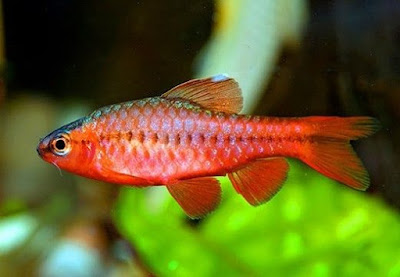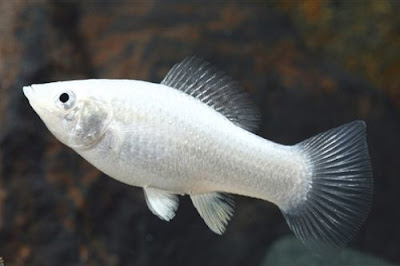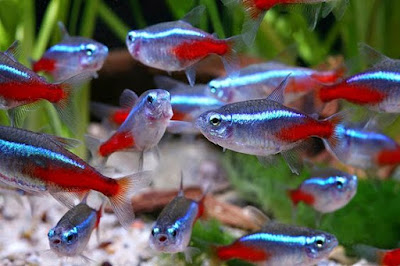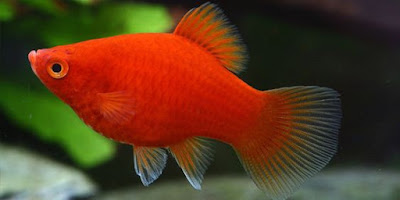Whilst this list is just a small example of the types of fish you can keep at home in a beginner aquarium, we believe that these 10 are perfect for those with little experience, and each tick all the boxes we mentioned before, when looking for tropical freshwater fish.
Betta
Betta fish are fresh water, small fish that are part of the Osphronemidae family. Betta fish come in approximately 65 species, with the most popular one being betta splendens, or also called Siamese Fighting Fish. For hundreds of years, the species has been selectively and extensively bred in order to improve its fighting abilities and to enhance its appearance as far as its tail and fin configurations, color combinations and color.
Usually betta fish that have been raised in captivity are distinguished and known based on the specific shape of their fins and tails. The most common kinds of betta fish are the Veil Tail, Rose Tail, Plakat, Half-Sun, Half-Moon, Fin Tail, Double Tail, Delta Tail, Crown Tail and Comb Tail.
Bettas in the wild are carnivores, and feed on carrion, shrimp, insect larvae, insects and small worms. You can feed betas kept in tanks mosquito larvae, daphnia, blood worms, brine shrimp and freeze-dried or frozen beef heart. For pet bettas, there are also small, round pellets and floating flakes that are available. There are comprised of a combination of minerals, vitamins, wheat flour, mashed up fish or shrimp and other ingredients. However, it is recommended to give live food to your pet bettas one or two times per week.
Wild betta are normally fairly dull in color. They are usually dull green and brown. The main colors of cultivated bettas are green, blue and red. However,as a result of selective breeding, bettas are now available in a wide variety of colors, that range from opaque white to black and everything in between, including purple, turquoise, green, blue, red, orange and yellow. There are even bettas in metallic hues like platinum, silver and gold as well as neon colors. Some bettas are solid colors, while others display incredible color combinations.
Cherry Barb
The Cherry Barb is a good choice for beginners. It comes from Sri Lanka. It is much more peaceful, slower and smaller than other barbs. As it matures, it develops its cherry color. Males turn a bright fire red when they reach breeding age. There is no distinction between sexes for juveniles and they all look very similar to an adult female. Cherry Barbs don't school, so keeping a pair is fine, although they will enjoy the company of their own kind. They eat standard flake foods and freeze dried blood worms. Quality flake foods and brine shrimp feedings will enhance colors.
For breeding, a separate tank should be used. Cherry Barbs will breed on a regular period of about every 3 weeks. Separating the male and female before breeding can help, but a bonded pair will develop a consistent pattern without being separated. The male begins chasing the female continuously when she is ready to spawn. When they breed, the male wraps around the female to fertilize the egg as she releases it. The process is repeated many times over a period of several minutes to an hour.
Cherry Barbs will spread eggs on finely leaved plants, such as Cabomba. Eggs that fall to the bottom of the tank will hatch there too. After spawning, the parents should be removed to increase survival rates. The parents will rarely search through gravel and plants for eggs if they adequately fed, so it is possible to leave them in the breeding tank and successfully raise some young. The fry will hatch in a few days and they are very tiny light brown to almost colorless slender slivers. They quickly begin searching for food among plant leaves, rocks and gravel. If the parents are left in the tank and there are no other predators, some of the fry will survive being consumed. Brine shrimp and finely crushed flakes are excellent food sources too. If breeding parents are left in the same tank with some fry, eventually the fry will become large enough to eat eggs and young fry themselves, at which point no new young will survive.
Danios
Danio is one of the best community fish to have in your home aquarium. In fact, they are also recommended to be part of the group of beginner freshwater fish suitable for aquarium novices because they don’t have special requirements when it comes to diet and will tolerate changes in water quality quite well. In community tank, you should buy at least 5 to 6 of these small fish and their presence will make the whole aquarium look stunning.
There are different types of danio with the most common like zebra (insert picture), leopard and pearl danio. Except for the giant danio, the rest are quite tiny which typically measures about 4 to 5 cm in length and all of them have an elongated body shape which makes them fast swimmers. Certain danios like the zebra fish has beautiful stripped blue white marking while the leopard danio has body marking with black and yellow spots. Pearl danio looks much simpler and they are generally grey and silver in color with slight shiny glow.
In terms of characteristic and behavior, they are generally peaceful and they won’t bother or care about presence of other types of fish although at times there will be some fin nipping occurrences take place but somehow this is not serious. They can be mixed with other tropical species like swordtail, neon tetra, hatchet fish, platy, guppy and corydoras catfish but I would avoid putting them with other larger sized fish such as angelfish, convict cichlids or discus because they will end up getting chased after and harassed.
When it comes to water quality, they will accept and thrive in water with pH between 6.0 to 8.0. The water temperature can be anywhere between 23 up to 27 degree Celsius although the best should be somehow close to the upper region at 27 to promote better appetite. When it comes to food, they will accept just about anything like floating flakes, pellet and mix of occasional live food will be beneficial to promote nice coloration.
Fire Mouth Cichilid
The Fire Mouth Cichlid is a very fascinating fish. I have previously owned a couple fire mouths and from my experience they are pretty calm until another fish enters it’s “home”. The fish has a grayish striped normal colored body but under it’s mouth it has a bright red beautiful color. When the fish gets into confrontation then it puffs out the red part under its mouth and it is very fascinating a beautiful to watch. I highly recommend this fish because of the beautiful color it adds to the fish tank. If you are going to purchase one of these fish I think that you should put it in a tank with similarly sized fish. I had it with Texas cichlids, Convicts, Jack Dempsey and other fish similar to these. All of these fish are similar in temperament as long as they are not breeding. However, when they are breeding they can tend to get very aggressive and even kill other fish.
Guppies are one of the most common species of fish found in home freshwater tanks. They are a hardy fish that adapt well to most environments. The guppies’ natural habitat can be found in North-East & South America. It is native to many Islands, including Barbados, Trinidad & Tobago, and the Virgin Islands as well as Brazil and Venezuela. They are highly adaptive and have been introduced to various regions around the world, usually with ill effects to the natural fish populations.
Guppies vary in size, with the males normally being smaller at 1.5-3.5 cm in length. Female guppies range in size from 3-6 cm in length. Males can have brightly coloured spots or stripes as well as other markings as a result of selective breeding, while females are usually grey in colour. Offspring of guppies are called fry and are live-born and self sufficient right away.
Guppies mature within 10-20 weeks and can live up to 2 years, in that time females can have many broods of fry. Lifespan in the wild differs from that of a live tank, but depending on the dynamics of the aquarium guppies can live slightly longer than in the wild.
With a well planned out aquarium that has plenty of rocks and vegetation, guppies can be a great addition. Be careful of predator fish within the tank however, and make sure the guppies have plenty of hiding spots for themselves and their fry. Guppies have also been known for infanticide, so make sure your guppies are well fed and not crowded, as these are common reasons for them to do it. With the proper knowledge and care, guppies make a great addition to any tank.
Mollies
The Molly can be found inhabiting freshwater streams and brackish environments in Mexico.
The fish commonly known as the Molly (Poecilia sphenops) or Mollies, is a freshwater fish that is often grouped in the same category as Swordtails and Guppies because it is a livebearer. These fish remain fairly small, growing to an average size around 3 to 4 inches and they are a very peaceful species which makes them a great addition to the community tank.
In the wild, Mollies are generally a dull silver color with a sprinkling of black spots. In captivity, however, Mollies have been selectively bred to produce a wide range of colors and patterns including gold, orange, red, green, black, and more. There are also some varieties of Molly which have unique fin and tail shapes such as the Sailfin Molly and the Lyretail Molly.
The Molly is a livebearing species of fish which means that it delivers live young – it does not lay eggs. Not only do Mollies bear live young, but they breed very readily in the home aquarium. Mollies have fast growth rates and large brood numbers so a few Mollies can quickly turn into a large colony.
Neon Tetra
The neon tetra is native to the black water and clearwater streams of south-eastern Colombia, eastern Peru and western Brazil.
Neon tetras are an incredibly beautiful species of tropical freshwater aquarium fish. It gets its name from the iridescent blue horizontal stripe that runs along each side of the fish from its nose to the base of the adipose fin, and the iridescent red stripe that begins at the middle of the body and extends to the base of the tail fin. The neon tetra also has a light blue back and a silver abdomen. Except for these markings, the fish is completely transparent and often loses its coloration in the night or when under stress. Neon tetras usually grow up to around 1.2 inches in length and can survive for up to three to four years given adequate care.
It is fairly difficult to sex neon tetras, but females will often be plumper in shape than the males and their blue lines will be slightly more curved.
To breed neon tetras, you will need to set up a dedicated breeding tank. The water of the breeding tank should be slightly acidic and as soft as possible. The tank should also be dimly lit and should include fine leaved plants or spawning mops for the eggs to be deposited in.
The eggs and resulting fry are extremely sensitive to light and the aquarium should be kept as dimly lit as possible for a few weeks once the fry eggs are laid. The parents should also be removed promptly from the breeding tank as they will devour their own eggs on sight.
Pearl Gourami
Also known as the Lace Gourami, this cool tropical freshwater fish is one of the most popular Gourami fish for aquarium lovers, thanks to it’s beautiful appearance and its hardy build. They are easy to care for, and can be kept in tanks with at least 30 gallons of water, but like many other types of Gourami, they do require space at the top of the tank so they can breath air.
When it comes to feeding time, the Pearl Gourami can eat a wide variety of different foods, both plant based, and meat based. For the best overall nutrition, we recommend feeding an algae based flake food, as well as live food such as brine shrimp, blood-worms and tubifex.
Pearl Gouramis do not like to live with aggressive fish, so keep that in mind when filling your aquarium. They also like a place to hide, so a small covering of floating ferns can give them a good place to hide and feel comfortable.
The Platy is native to the warm waters along the east coast of southern Mexico and Central America. These fish tend to inhabit slow-moving waters such as ditches, canals, and warm springs.
The Platy fish is a freshwater fish belonging to the genus Xiphophorus that is commonly lumped in with other livebearers like Swordtails, Mollies, and Guppies. Platies are fairly small fish, growing no more than 3 inches long, and they are peaceful and non-aggressive – this makes them a great addition to the community tank.
The wild Platy is drab and dull in coloration with no distinctive markings. The Platy known in the aquarium trade has been selectively bred to exhibit a variety of colors and patterns ranging from red, yellow, and orange, to black, silver and green.
The Platy is a live-bearing species of fish which means that it bears live, fully formed fry instead of laying eggs. Platies are prolific breeders and they have been known to produce as many as 80 fry in one brood. Platies are capable of breeding about every 30 days.
Sword Tails
A relatively hardy and easy to care for livebearer, the swordtail is one of the most popular aquarium fish species among beginner aquarists. Swordtails get their name from the distinctive sword-like extension on the male’s tail fin, which can sometimes grow almost as long as their bodies. Swordtails are also the largest growing species among livebearers and adult swordtails can reach up to six inches in length.
Swordtails are native to the North and Central areas of America including Veracruz, Mexico and northwestern Honduras.
While wild swordtails are mostly a drab green in color, most aquarium varieties come in a range of colors including red, orange, black, tuxedo, gold, spotted, neon, albino, silver and blue.
Like most livebearers, swordtails reproduce quite prolifically and require no special effort when breeding. They reach sexual maturity at around three months old and given adequate hiding spaces swordtails can quickly overpopulate an aquarium within a year. When breeding swordtails, it is advisable to remove pregnant females into separate breeding tanks. Swordtails will quickly devour their own fry and breeders should use a breeding box or a heavily planted aquarium to ensure that the fry survive.
In the wild, sword tails would typically be found in fast flowing water, so if you can emulate this by keeping a strong flow of water somewhere in your tank, they will be grateful, and will feel more at home.
Thanks and Share These Baeutiful Fish with Your Friends..























Along with mollies, i love to keep white sailfins due to their beautiful fins and appearance. What do you keep with them, i would love to see an opinion for a peaceful mate :)
ReplyDelete